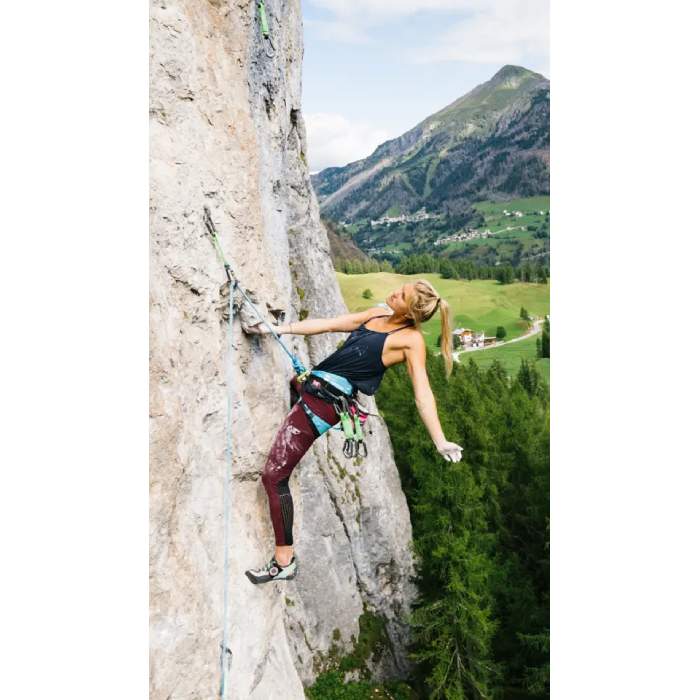Sizing Chart for all Mens, Womens, and Childrens Harnesses
Helia
Description
Incredible comfort coupled with a low weight and a compact pack size—this is the best way to summarize the HELIA. The fit is particularly suited to both men and women with a thinner waist. Our innovative 3D Pad technology adopts the concept of the 3D-shaped waist belt and leg loops but the padding is minimized to strategically useful places, where it is intensively used. The butterfly shape of the waist belt optimally distributes loads and enhances hanging comfort. The use of essential padding only and further details such as the 20 mm aluminum Slide Block buckle on the waist belt and the new, far more flexible tie-in loop reduce the weight and enable a compact pack size. The leg loops can be individually adjusted using 15 mm Slide Block buckles. Textile sleeves over the buckles protect the webbing against premature wear.
- Longer leg loop bridge enables optimal positioning above the hip bones at all times
- Tie-in point with Dyneema wear indicator, which reveals internal red threads in case of increased abrasion
- 20 mm Slide Block buckle on the waist belt can be fully opened for a comfortable and secure harness fit
- 3D Pad technology: unsurpassed support and comfort through three-dimensional molding, extensive force distribution, and intelligently reinforced padding
- Outer fabric made from bluesign®-certified materials
- Additional, small bag that can be attached to the waist belt for topos, keys, energy bars, etc.
Retail price
When you click a link below and then checkout online, no matter what you buy (climbing gear or not), we get a small commission that helps us keep this site up-to-date. Thanks!
Weight (g)  WeightIn grams, the weight, as stated by the manufacturer/brand. If there are differences in weight (due to multiple sizes or optional accessories) we'll list them here. The default weight is the middle-most size, often this is size M. | 440 g XS: 395 g / 13.9 oz
S: 420 g / 14.8 oz
M: 440 g / 15.5 oz
L: 455 g / 16 oz
(weight converted from grams to ounces)
|
| Fit | Unisex |
| Sizes | XS, S, M, L, XL |
Gear Loops  Number of Gear LoopsGear loops are used to hold gear (quickdraws, cams, etc) onto your harness. 4 gear loops is most common. 
0 - 1 Gear LoopsMost often on full body harnesses or guide/gym style harnesses. 2-3 Gear LoopsMostly found on lighter harnesses made for [ski] mountaineering or high-end sport climbing where weight is a high priority. 4 - 5 Gear LoopsThe standard/most common number for climbing harnesses. Perfect for sport and trad. More Than 6 Gear LoopsDesigned for long multi-pitch and big wall climbing, found on harnesses made to hold the maximum amount of gear. Worth ConsideringOccasionally, the number of gear loops will change on a harness model depending on the size. There could be 7 gear loops for the med/large but only 5 gear loops for the xsmall/small. In this case we list the highest number for the filters, and then write an explanation on the product page like, “Size S/XS can only fit 5 gear loops.” | 5 Gear loops |
Ice Clip Slots  Ice Clip SlotIce clipper slots are made to fit a carabiner that holds ice screws. These slots are generally only used by ice climbers but there is no disadvantage to having them on your harness. 
Less than 40% of harnesses will have ice clipper slots. And those harnesses will usually have 2 or 4 slots, often located next to, or between, the gear loops. | Yes, 4 |
| Belay / Tie-In | One Loop |
| Waist Buckle Type | Quick Adjust |
| Leg Buckle Type | Quick Adjust |
| Drop Seat | Yes |
Haul Loop  Haul LoopTrad climbers often look for a haul loop as they're intended to haul a rope (second line) or pack (while you climb the chimney). 
A haul loop can also hold shoes or other accessories. Although not the intended use, it is also commonly used to hold a chalk bag. | No |
| Certification | EN |
| Size Chart | XS |
No reviews yet.
How to use Edelrid Harness, safety, lifespan, storage and care with instructional pictures.
A pictoral representation of UIAA-105 and EN-12277 standards for harnesses.
The UIAA equipment standard provides a baseline for equipment performance in a test lab under controlled conditions on new equipment. Although these test conditions are relevant to the conditions encountered climbing, conditions encountered at the crags and the condition of the equipment are equally important. This recommendation from the UIAA member federation The British Mountaineering Council (BMC) provides vital equipment information that is NOT explicitly addressed in the standard, particularly failure modes of the equipment and recommendations for the use, inspection, maintenance, and retirement of equipment.




























